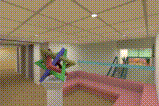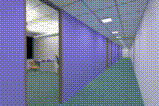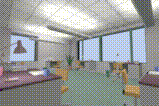Radiosity Lighting Simulation



Thomas Funkhouser
Overview:
Radiosity methods accurately simulate diffuse indirect illumination and
shadows, and thus are used to generate realistic-looking lighting models
for a variety of virtual environments, including building interiors. A
difficult challenge for radiosity systems is managing the algorithmic complexity
(O(n^2)) and massive data storage requirements (GBs) typical in such computations.
We have developed a radiosity system that computes radiosity solutions
for very large polygonal models.
The first innovation in this system is that it uses visibility oracles
and hierarchical methods to: 1) reduce the number of polygon-polygon interactions
considered, and 2) partition the computation into a sequence of subcomputations
each requiring a relatively small working set. Unlike any other system,
the radiosity solver stores the evolving solution in a disk-resident database
and loads only the working set for the current subcomputation into memory
as the computation proceeds. Subcomputations are ordered so as to minimize
the impact of database I/O operations. Using these techniques, the system
is able to cull over 99.999999% of the potential interactions and requires
only 0.24% of the database (14.5MB) to be stored in memory at any given
time during experiments with large architectural models.
The second innovation is that it supports execution of multiple hierarchical
radiosity solvers working on the same radiosity solution in parallel. The
system is based on a group iterative approach that repeatedly: 1) partitions
patches into groups, 2) distributes a copy of each group to a slave processor
which updates radiosities for all patches in that group, and 3) merges
the updates back into a master solution. The primary advantage of this
approach is that separate instantiations of a hierarchical radiosity solver
can gather radiosity to patches in separate groups in parallel with very
little contention or communication overhead. This feature, along with automatic
partitioning and dynamic load balancing algorithms, enables our implemented
system to achieve significant speedups running on moderate numbers of workstations
connected by a local area network.
This system has been used to compute the radiosity solution for a furnished
model of Soda Hall. The model represents five floors of a large building
with approximately 250 rooms containing furniture. It was constructed with
14,234 clusters comprising 280,836 patches, 8,542 of which were emitters
and served as the only light sources. The total area of all surfaces was
75,946,664 square inches. Three complete iterations were made through all
patches using an average of 4.96 slave processors in 168 hours. The entire
computation generated 7,649,958 mesh elements and evaluated 374,845,618
element-to-element links.
This is joint work with Seth
Teller, Celeste Fowler, and Pat
Hanrahan.
Related Links:
Related Publications:
-
Thomas A. Funkhouser.
Coarse-Grained Parallelism for
Hierarchical Radiosity Using Group Iterative Methods.
Computer Graphics (SIGGRAPH `96), New Orleans,
LA, August, 1996.
-
Seth Teller, Celeste Fowler, ThomasFunkhouser, and Pat Hanrahan.
Partitioning and Ordering Large
Radiosity Computations.
Computer Graphics (SIGGRAPH `94), Orlando, FL,
August, 1994, p. 443-450.
-
Thomas A. Funkhouser.
Database and Display Algorithms
for Interactive Visualization of Architectural Models.
PhD Thesis, Computer Science Division, UC Berkeley, September,
1993.
Also available as UC Berkeley Technical Report UCB/CSD93/771.





